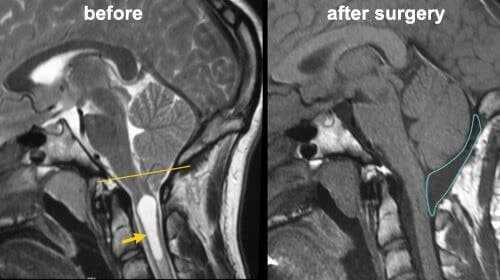Chiari Decompression Surgery in Pune
It is a type of congenital condition in which a part of the brainstem along with the cerebellar tonsils herniates through the foramen magnum which is considered an opening in the skull base. Normally, cerebellar tonsils lie above the foramen magnum. Due to some unexplained reasons, there is herniation of the cerebellar tonsils, and they hang lower. As a result of which the foramen magnum is congested and compresses the brainstem and often impairs CSF flow. In some severe cases may result into formation of syrinx (cyst) in the spinal cord.
Such patients have symptoms of dissociative anesthesia in which one has loss of pain and temperature sense but touch and pressure sense is intact mainly in the upper extremities.
Patients with a low lying cerebellar tonsils and without symptoms, undergo more imaging to determine if the CSF flow is impaired. If they have a normal CSF flow, then such cases can be treated conservatively. If CSF flow is impaired, surgery is indicated.
Surgery often involves Foramen Magnum decompression along with adhesionolysis, with or without removal of the C1 posterior arch. Dura is opened, keeping the arachnoid intact. In some cases we do an augmented duraplasty using a tissue graft, to decompress the cerebellum and resolve the CSF flow obstruction. This improves symptoms in many of the patients.

